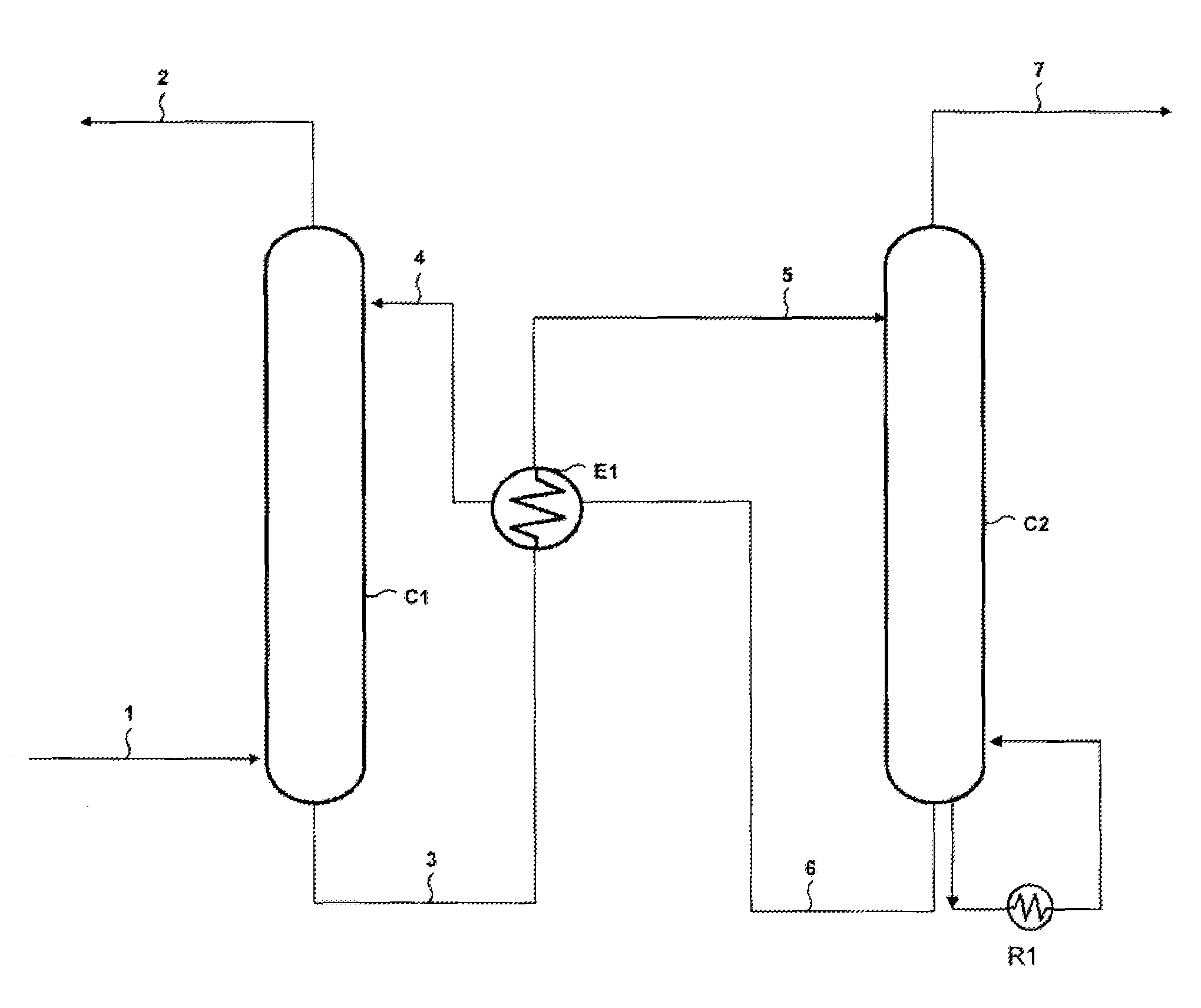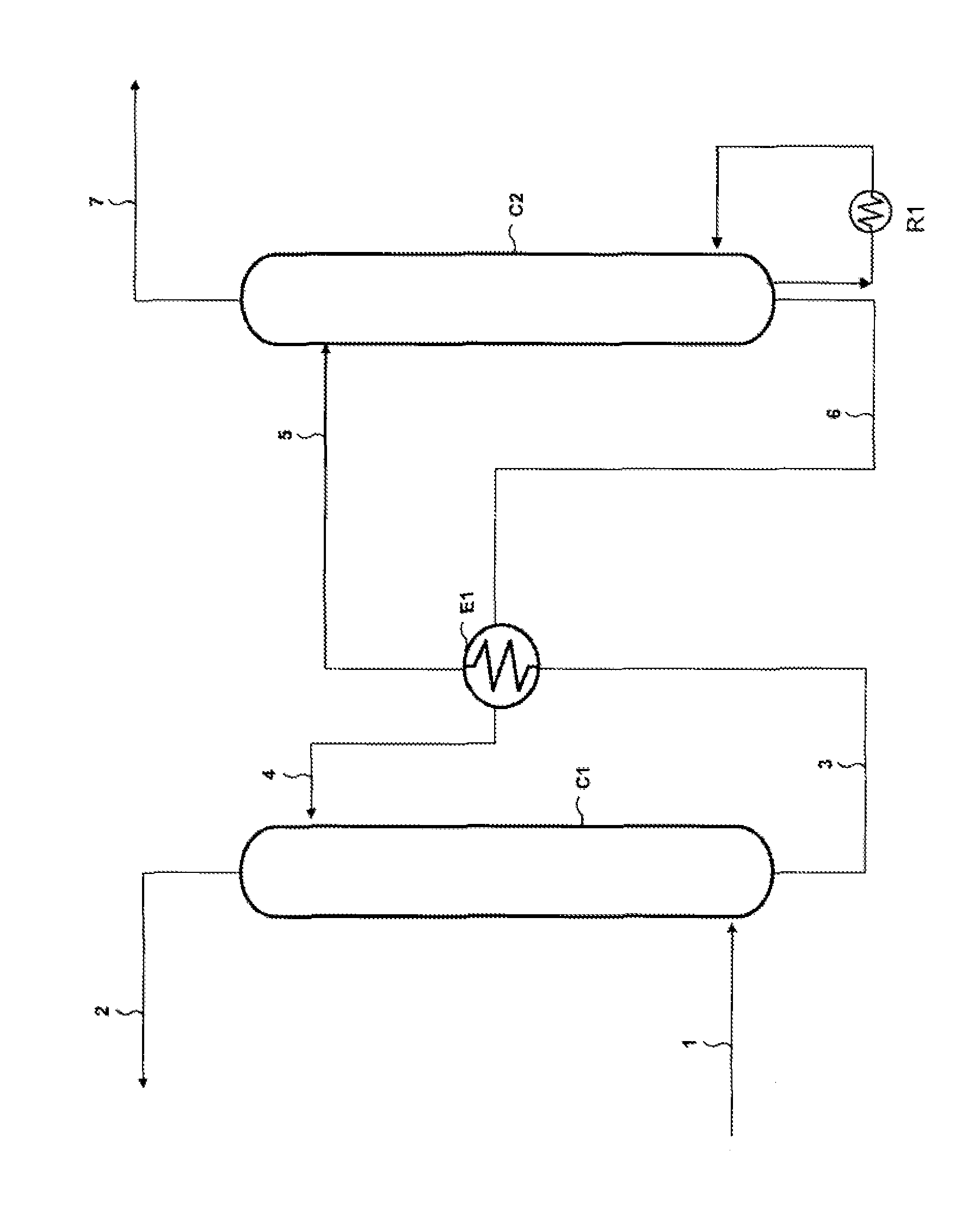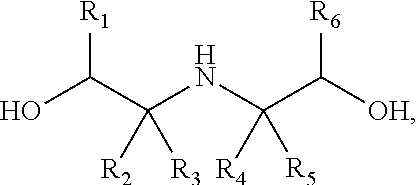Process for removing acidic compounds from a gaseous effluent with an absorbent solution based on dihydroxyalkylamines bearing severe steric hindrance of the nitrogen atom
- Summary
- Abstract
- Description
- Claims
- Application Information
AI Technical Summary
Benefits of technology
Problems solved by technology
Method used
Image
Examples
example 1
Synthetic Procedure
[0116]The examples that follow illustrate the synthesis of preferred molecules of the invention according to the synthetic route described previously, it being understood that all the possibilities for the synthesis of these molecules both as regards the synthetic routes and as regards the possible procedures are not described herein.
N-(2′-Hydroxyethyl)-2-amino-2-methyl-1-propanol
[0117]To a solution of 1.68 mol of 2-amino-2-methyl-1-propanol in 150 ml of water is added with stirring, over one hour, 0.83 mol of ethylene oxide at a temperature maintained below 20° C. The water and the excess 2-methyl-2-amino-1-propanol are then removed by distillation and the residual product is recrystallized from ethyl acetate to obtain, after drying, 72 g of N-(2′-hydroxyethyl)-2-amino-2-methyl-1-propanol, the structure of which is confirmed by NMR analysis (CDCl3):
68.2 ppm: HO—CH2—C(CH3)2—NH—CH2—CH2—OH
53.4 ppm: HO—CH2—C(CH3)2—NH—CH2—CH2—OH
23.5 ppm: HO—CH2—C(CH3)2—NH—CH2—CH2—OH
43...
example 2
Capacity and Selectivity for Removal of H2S from a Gaseous Effluent Containing H2S and CO2 with a Solution of Amine of Formula (I)
[0121]An absorption test at 40° C. is performed on aqueous solutions of amine in a perfectly stirred reactor that is open gas side.
[0122]For each solution, the absorption is performed in a liquid volume of 50 cm3 by sparging with a gaseous stream consisting of a nitrogen:carbon dioxide:hydrogen sulfide mixture of 89:10:1 in volume proportions, at a flow rate of 30 NL / h for 90 minutes.
[0123]After the test, the H2S charge obtained (α=number of moles of H2S / kg of absorbent solution) and the absorption selectivity toward CO2 are measured.
[0124]This selectivity S is defined in the following manner:
[0125]S=αH2SαCO2×(CO2concentrationofthegaseousmixture)(H2Sconcentrationofthegaseousmixture)
i.e., under the conditions of the test described here
[0126]S=10×αH2SαCO2
[0127]By way of example, the charge and the selectivity between absorb...
example 3
Capacity for and Selectivity of Removal of H2S from a Gaseous Effluent Containing H2S and CO2 with a Solution of Amine of Formula (II)
[0130]The procedure of Example 2 is repeated, with the exception of an absorbent solution of (N-methyl-N-hydroxyethyl)-3-amino-2-butanol according to formula (II), at 50% by weight in water. This solution according to the invention is compared with an absorbent solution of methyldiethanolamine (MDEA) at 47% by weight in water, which constitutes the reference absorbent solution for a selective removal of H2S in the treatment of natural gas. MDEA is a comparative example of a tertiary di(hydroxyalkyl)monoamine, but in which all the groups R7 to R11 are hydrogen atoms. The example of the absorbent solution according to the invention is also compared with an absorbent solution of tert-butyldiethanolamine (TBDEA) at 50% by weight in water, a tertiary monoamine with severe steric hindrance of the nitrogen atom according to the general formula of document U....
PUM
| Property | Measurement | Unit |
|---|---|---|
| Temperature | aaaaa | aaaaa |
| Temperature | aaaaa | aaaaa |
| Temperature | aaaaa | aaaaa |
Abstract
Description
Claims
Application Information
 Login to View More
Login to View More - R&D Engineer
- R&D Manager
- IP Professional
- Industry Leading Data Capabilities
- Powerful AI technology
- Patent DNA Extraction
Browse by: Latest US Patents, China's latest patents, Technical Efficacy Thesaurus, Application Domain, Technology Topic, Popular Technical Reports.
© 2024 PatSnap. All rights reserved.Legal|Privacy policy|Modern Slavery Act Transparency Statement|Sitemap|About US| Contact US: help@patsnap.com










